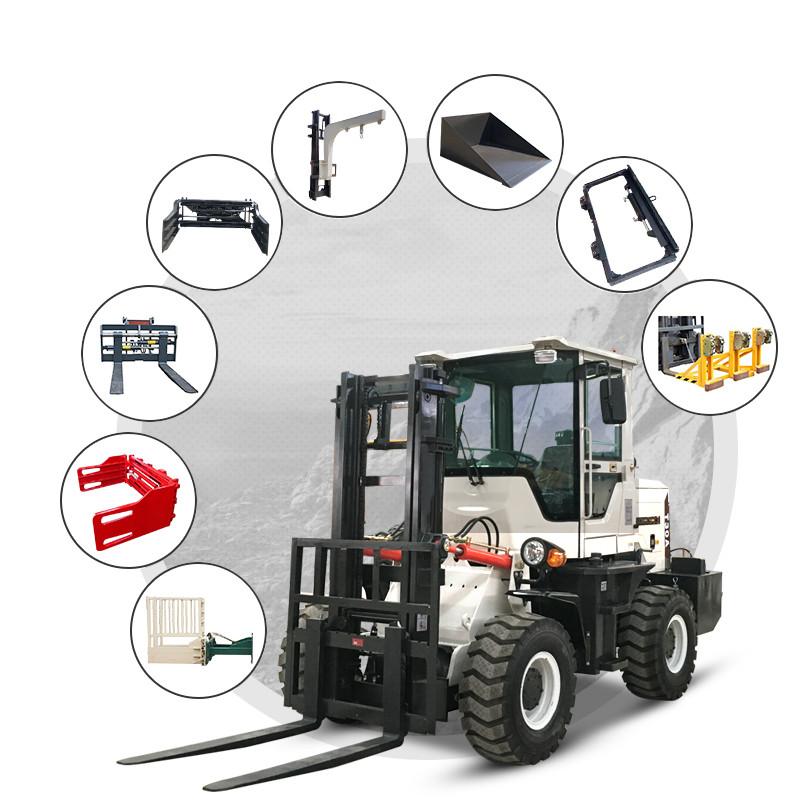Rough terrain forklifts and all-terrain forklifts are both designed for challenging environments, but they have distinct features and applications. Here's a detailed comparison:
1. Design and Construction
| Aspect | Rough Terrain Forklift | All-Terrain Forklift |
|---|---|---|
| Tires | Large, deep-tread pneumatic tires (e.g., 12-16 inches) for traction on loose surfaces (gravel, mud). | Aggressive, heavy-duty pneumatic tires with deeper lugs or even hybrid designs for versatility. |
| Chassis/Suspension | Rigid chassis with minimal suspension; built for stability on uneven ground. | Flexible chassis with advanced suspension systems (e.g., independent suspension) for better shock absorption and articulation. |
| Weight/Clearance | Heavier build (to handle rough loads); higher ground clearance (12-18 inches) to avoid obstacles. | Lighter or comparable weight with adjustable ground clearance (via suspension or tires) for varied terrains. |
| Engine Power | Typically diesel-powered with moderate horsepower (50-100 HP) for steady torque. | More powerful engines (100+ HP) with turbocharging options for demanding tasks and steep inclines. |

2. Terrain Capability
- Rough Terrain Forklifts:
- Excel in uneven, outdoor environments like construction sites, lumber yards, or gravel pits.
- Struggle on extremely soft surfaces (e.g., deep mud or sand) due to limited traction and suspension.
- Ideal for moderate obstacles (rocks, small ditches) but not designed for extreme off-roading.
- All-Terrain Forklifts:
- Designed for extreme versatility, including muddy, sandy, snowy, or rocky terrain.
- Features like 4-wheel drive (4WD), articulated steering, and (differential locks) enhance traction on slippery or loose surfaces.
- Can handle steep inclines (20°+), deep ruts, and even shallow water crossings.
3. Maneuverability and Control
- Rough Terrain Forklifts:
- Stiffer steering and less articulation, making them less agile in tight spaces.
- Prioritize stability over maneuverability (e.g., wide wheelbase to reduce tipping risk).
- All-Terrain Forklifts:
- More agile due to articulated frames or 4-wheel steering, allowing sharper turns in confined or winding paths.
- Better control on slopes thanks to advanced suspension and weight distribution.
4. Applications
- Rough Terrain Forklifts:
- Common in industries like construction, agriculture, and warehousing (for outdoor loading/unloading).
- Tasks: Moving pallets, machinery, or materials on moderately rough surfaces.
- All-Terrain Forklifts:
- Used in remote or harsh environments: mining, oil fields, forestry, or disaster relief.
- Tasks: Heavy lifting in unstable terrain, navigating through debris, or working on unimproved roads.
5. Additional Features
- Rough Terrain Forklifts:
- Simpler maintenance requirements (fewer complex components).
- Often lack advanced electronics; focused on durability.
- All-Terrain Forklifts:
- May include GPS tracking, telematics, or climate-controlled cabs for operator comfort in extreme conditions.
- Some models offer attachments (e.g., snow plows, winches) for multi-functionality.
Key Takeaway
- Choose a rough terrain forklift for predictable outdoor jobs with moderate terrain challenges (e.g., a construction site with gravel paths).
- Choose an all-terrain forklift for unpredictable, extreme environments where versatility and heavy-duty performance are critical (e.g., a mountainous logging site).
Both types prioritize outdoor capability, but all-terrain forklifts offer superior adaptability to the most rugged and varied conditions.





